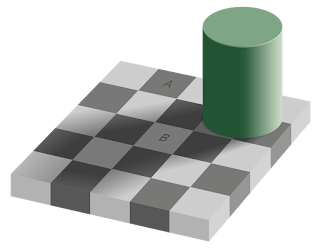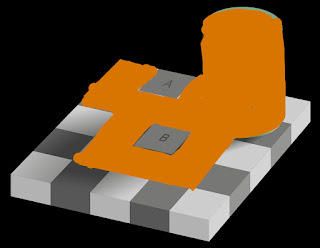Checker Shadow illusion
Which square is darker here; A or B?
The A appears darker than B here. But that's not the reality. Both shares equal levels of brightness & gray levels. A printer would you same ink to print those squares.
What's challenge to visual system here?
The task given to your visual system here is to determine the color of the object & here it is gray level. But shadow of cast plays here big role. The square under shadow reflecting less light than the one is not in shadow. Visual system need to do several tricks to compensate that shadow effect & determine the exact color of the square under shadow.
What tricks visual system uses?
1. Local contrast : Irrespective of shadow, a lighter check surrounded by more lighter checks is perceived as a check with more average lightness & vice versa. In the figure, the light check in shadow is surrounded by darker checks. Thus, even though the check is physically dark, it is light when compared to its neighbors. The dark checks outside the shadow, conversely, are surrounded by lighter checks, so they look dark by comparison.
2. Shadows often have soft edges while paints (here checks) have sharp edges. The visual system tends to ignore gradual changes in light level, so that it can determine the color of the surfaces without being misled by shadows. In this figure, the shadow looks like a shadow, both because it is fuzzy and because the shadow casting object is visible.
3. The "paintness" of the checks is aided by the form of the "X-junctions" formed by 4 abutting checks. This type of junction is usually a signal that all the edges should be interpreted as changes in surface color rather than in terms of shadows or lighting.
Conclusion :
The effect illustrates success rather than failure of our visual system. The illusion asking our visual system to act as a light meter; but it's definitely not built for it. What's the success of our visual system here is it breaks the information into meaningful components & then perceive different aspects of objects.
Courtesy : Wikipedia
 |
| A is darker or B |
The A appears darker than B here. But that's not the reality. Both shares equal levels of brightness & gray levels. A printer would you same ink to print those squares.
 |
| Equally Darker |
What's challenge to visual system here?
The task given to your visual system here is to determine the color of the object & here it is gray level. But shadow of cast plays here big role. The square under shadow reflecting less light than the one is not in shadow. Visual system need to do several tricks to compensate that shadow effect & determine the exact color of the square under shadow.
What tricks visual system uses?
1. Local contrast : Irrespective of shadow, a lighter check surrounded by more lighter checks is perceived as a check with more average lightness & vice versa. In the figure, the light check in shadow is surrounded by darker checks. Thus, even though the check is physically dark, it is light when compared to its neighbors. The dark checks outside the shadow, conversely, are surrounded by lighter checks, so they look dark by comparison.
2. Shadows often have soft edges while paints (here checks) have sharp edges. The visual system tends to ignore gradual changes in light level, so that it can determine the color of the surfaces without being misled by shadows. In this figure, the shadow looks like a shadow, both because it is fuzzy and because the shadow casting object is visible.
3. The "paintness" of the checks is aided by the form of the "X-junctions" formed by 4 abutting checks. This type of junction is usually a signal that all the edges should be interpreted as changes in surface color rather than in terms of shadows or lighting.
Conclusion :
The effect illustrates success rather than failure of our visual system. The illusion asking our visual system to act as a light meter; but it's definitely not built for it. What's the success of our visual system here is it breaks the information into meaningful components & then perceive different aspects of objects.
Courtesy : Wikipedia